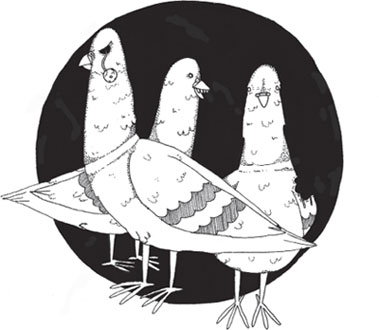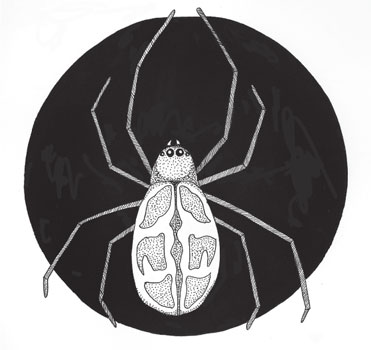The Little Book of the End of the World (23 page)
Read The Little Book of the End of the World Online
Authors: Ken Mooney

The image of the zombie as an undead creature feeding on flesh is mostly derived from George Romero, whose 1968 film
Night of the Living Dead
was amongst the first to portray our current image of this particular branch of the undead. This image has become enduringly popular, and most Hollywood zombies either neglect or outright ignore their voodoo origins in favour of portraying a world where human survivors struggle with each other in a planet overrun by undead fiends.
However, that doesn’t stop some recent news stories from using the word ‘zombie’ with abandon and suggesting that this breed of zombie isn’t too far removed from real life.
The Miami Zombie
On 26 May 2012, Rudy Eugene (31) assaulted a homeless man named Ronald Poppo (65) in a particularly vicious attack. Most of the attack was recorded on Miami traffic cameras, and authorities have since used these to recreate a fuller picture of the day’s events.
After experiencing car trouble, Eugene left his car and proceeded to walk the rest of his journey. During his walk, Eugene stripped completely naked. When he encountered Poppo on the side of the street, Eugene proceeded to attack him, removing Poppo’s trousers and then biting off parts of his face. Poppo survived and his later testimony suggests that during the attack, Eugene plucked out his eyeballs.
One of the most terrifying elements of this attack lies in Eugene’s reaction: upon the arrival of police officers at the scene, Eugene ignored their demands that he stop, and instead growled at them. He was shot five times before the attack was brought to a close, with eyewitnesses suggesting that he shook off the initial bullets.
Reports from Poppo and the attending officer, Jose Ramirez, suggested that Eugene was acting as if on drugs, although blood tests after his death found only marijuana in his system. However, toxicologists working on the case were quick to point out that the drugs industry is advancing at a quicker rate than tests can keep up.
While multiple news outlets reported this story with the word ‘zombie’, it is, unfortunately, not unique in its gruesome content.
May 2012 saw a number of similar attacks around the world, with several blogs and Internet sites linking the events and painting a picture of an impending zombie apocalypse:
![]() Pornographic actor Luka Magnotta posted a video online, implied to be part of a horror movie. The footage showed the brutal murder of a naked man, with some of his flesh consumed in the process. The video was reported to the site’s owners, and when police investigated, they linked this video to the murder of Chinese student Jin Lun, whose body parts had since been mailed to various Canadian state departments. Magnotta was subsequently arrested in an Internet café in Germany, whilst reading news reports about his own crime.
Pornographic actor Luka Magnotta posted a video online, implied to be part of a horror movie. The footage showed the brutal murder of a naked man, with some of his flesh consumed in the process. The video was reported to the site’s owners, and when police investigated, they linked this video to the murder of Chinese student Jin Lun, whose body parts had since been mailed to various Canadian state departments. Magnotta was subsequently arrested in an Internet café in Germany, whilst reading news reports about his own crime.
![]() In Hackensack, New Jersey, police responded to a 911 call and found themselves confronting a knife-wielding Wayne Carter. Carter reportedly stabbed himself multiple times, cutting himself open and revealing his intestines. Carter then proceeded to throw his skin and intestines at the arresting officers.
In Hackensack, New Jersey, police responded to a 911 call and found themselves confronting a knife-wielding Wayne Carter. Carter reportedly stabbed himself multiple times, cutting himself open and revealing his intestines. Carter then proceeded to throw his skin and intestines at the arresting officers.
![]() In Maryland, Ghanaian exchange student Kujoe Bonsafo Agyei-Kodie was staying with the Kinyua family pending extradition after his visa had expired. The Kinyua’s 21-year-old son Anthony was also staying with them after being released on bail following an attack in his college dorms. Agyei-Kodie was reported missing on 25 May, with police calling to the home after Anthony’s brother found organs stored in the house’s basement, leading to Anthony’s subsequent arrest and incarceration.
In Maryland, Ghanaian exchange student Kujoe Bonsafo Agyei-Kodie was staying with the Kinyua family pending extradition after his visa had expired. The Kinyua’s 21-year-old son Anthony was also staying with them after being released on bail following an attack in his college dorms. Agyei-Kodie was reported missing on 25 May, with police calling to the home after Anthony’s brother found organs stored in the house’s basement, leading to Anthony’s subsequent arrest and incarceration.
Although these events paint a chilling picture of the United States in May 2012, there are other stories from the twenty-first century that are similar in content and brutality. In a well-publicised case from Germany in 2001, Armin Meiwes was charged with the murder and cannibalistic consumption of Bernd Jürgen Armando Brandes. The incident was covered internationally, with several headlines focusing on the fact that Meiwes had recruited Brandes as a willing victim via a personal advert, with Brandes participating in the process.
THE KILLER ANIMALS OF 2013
The year 2013 saw a spate of animal attacks that were reported throughout the world, many of which had deadly consequences, even taking the form of quasi-biblical plagues.
Russian Zombie Birds
In August 2013, residents of Moscow began to notice some unusual behaviour amongst the city’s feathered inhabitants and concerns were raised about the significant increase in the number of dead and dying pigeons, many of which dropping from the sky. Those that were still living ignored nearby humans, walking around in circles or standing on their heads.
The pigeons were given the nickname of ‘zombie pigeons’ in local and foreign media. Some newspapers and media outlets even suggested that these events signalled the beginning of the Endtimes, pointing towards a prophecy by Russian mystic Gregori Rasptuin. Unfortunately, most of these newspapers only point towards each other as a source, with none actually referencing this questionable prediction directly.
Local veterinarians, meanwhile, insist that these pigeons were just suffering from a particularly bad bout of salmonella poisoning, and that mass animal deaths are a regular occurrence.
Attack of the Killer Giant Hornets
After rapid urbanisation and a particularly humid summer in northern China, June 2013 saw a series of aggressive attacks of a specific type of hornet that was a lot bigger and scarier than you might think.
The Asian giant hornet is native to the area, clocking in at a terrifyingly impressive 2.5cm in length, with a stinger that accounts for nearly 0.5cm. The breed is known locally as ‘yak killer hornets’, given their size and the considerable amounts of poison they carry in their sting. These monstrous creatures accounted for over 2,000 attacks over a short period of time, and at least forty of these cases resulted in death, many of which were caused by an allergic reaction to the hornet’s venom.

Curse of the Spiders
Hornets weren’t the only creatures out to poison us in the summer of 2013, and there were a number of attacks a lot closer to home and by something that looks a lot more innocent. However, these cases might justify that arachnophobia you’ve always had.
A humid summer was once again to blame when a particular family of spider became commonplace around the British countryside: these large creepy-crawlies are similar in size and shape to the deadly black widow, earning themselves the nickname ‘false widows’. While these spiders aren’t deadly, they still got blamed for deaths and injuries to household pets, labourers and children; in the finest tradition of tabloid journalism, those same newspapers also ran stories involving concerned parents terrified to allow their children out to play.

PART 4
As we’ve seen throughout this book, there are many different forms and shapes that the Apocalypse could take, from an immediate event that causes the destruction of the entire planet to a literal slow burn that might spell certain death at some stage in the future.
As we come to the end of our journey, we’ll look at just some of these events, as well as some hints that might even help you survive when the Four Horsemen come knocking.
20
A BEGINNER'S GUIDE TO SURVIVING THE APOCALYPSE
The survivalist movement has its origins in the post-nuclear world of the 1950s: having seen what the nuclear bomb could do in Japan, the world waited with bated breath for all-out nuclear war to begin. But this prolonged waiting didn't appeal to everyone's tastes. Survivalists, or preppers, prepared for the potential Apocalypse with bomb shelters and food stores, learning basic survival skills and teaching them to their families.
Several generations later, survivalism has become a way of life for thousands of people, many of whom have been raised and taught by parents and grandparents. Not all preppers focus on the ultimate end of the Apocalypse, however. Survivalism means being prepared for electrical outages, earthquakes, floods and other natural disasters, all the while being prepared to be entirely self-sustaining should the need arise.
WHAT TO PREP FOR
There are plenty of things that we take for granted in the modern world that form the basic foundations of survivalism: food, water and healthcare are obviously at the top of the list. Survivalism is a personal practice, and as such, there are many different types of preppers: some place a practical emphasis on what they are preparing for, like natural disasters or civil disobedience. For others, survivalism is just one outlet for a greater paranoia about zombies of the biblical Endtimes.
When it comes to survivalism, even the most over-the-top fears should not be discounted, with many preppers suggesting that having a small item and not needing it is preferable to going without when this is an important requirement. You should prepare for what could be the worst-case scenario in such a way that you are still comfortable when this scenario doesn't come to pass.
There are several different levels of preparedness practiced by survivalists, and the chances of survival increase significantly with each level: estimates suggest that people with zero preparation would survive no more than a week, while the ultimate prepper â one who is prepared to be entirely self-sufficient â could go âoff-the-grid' and survive for upwards of three years.
